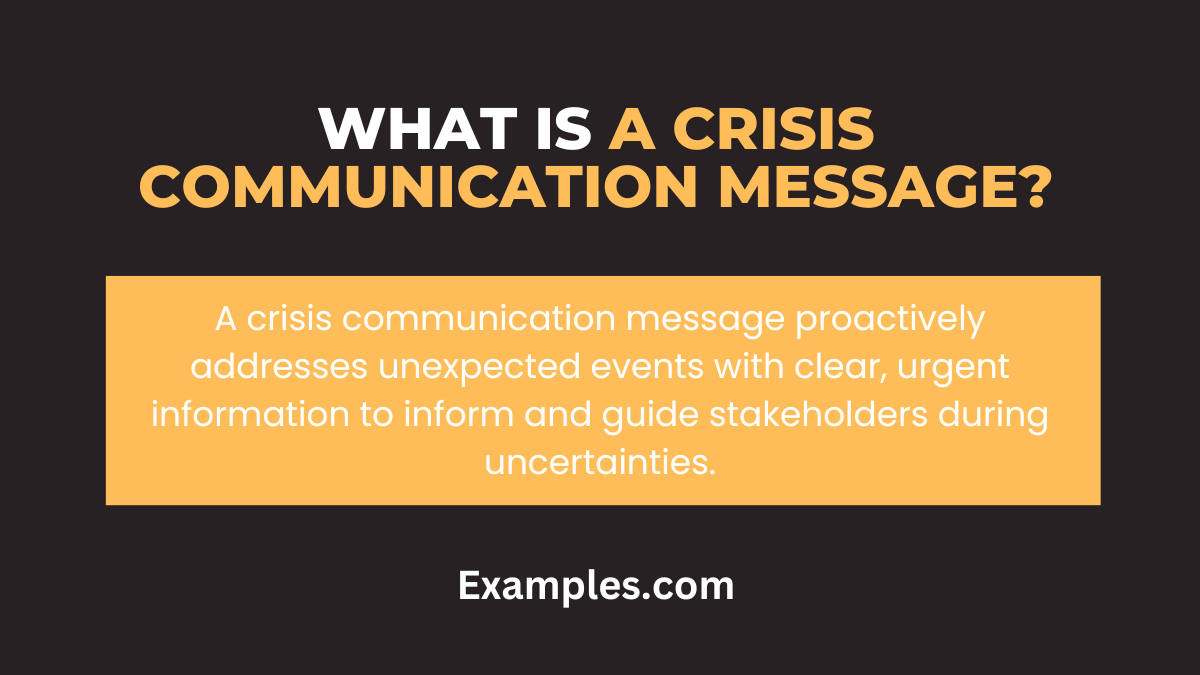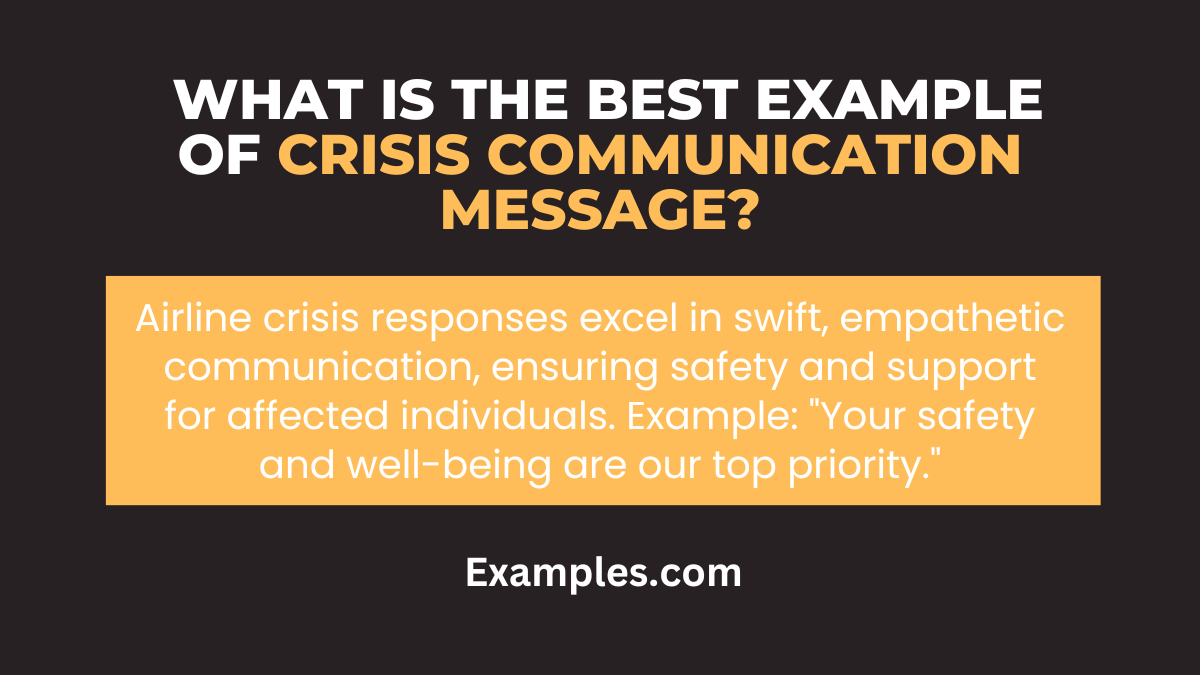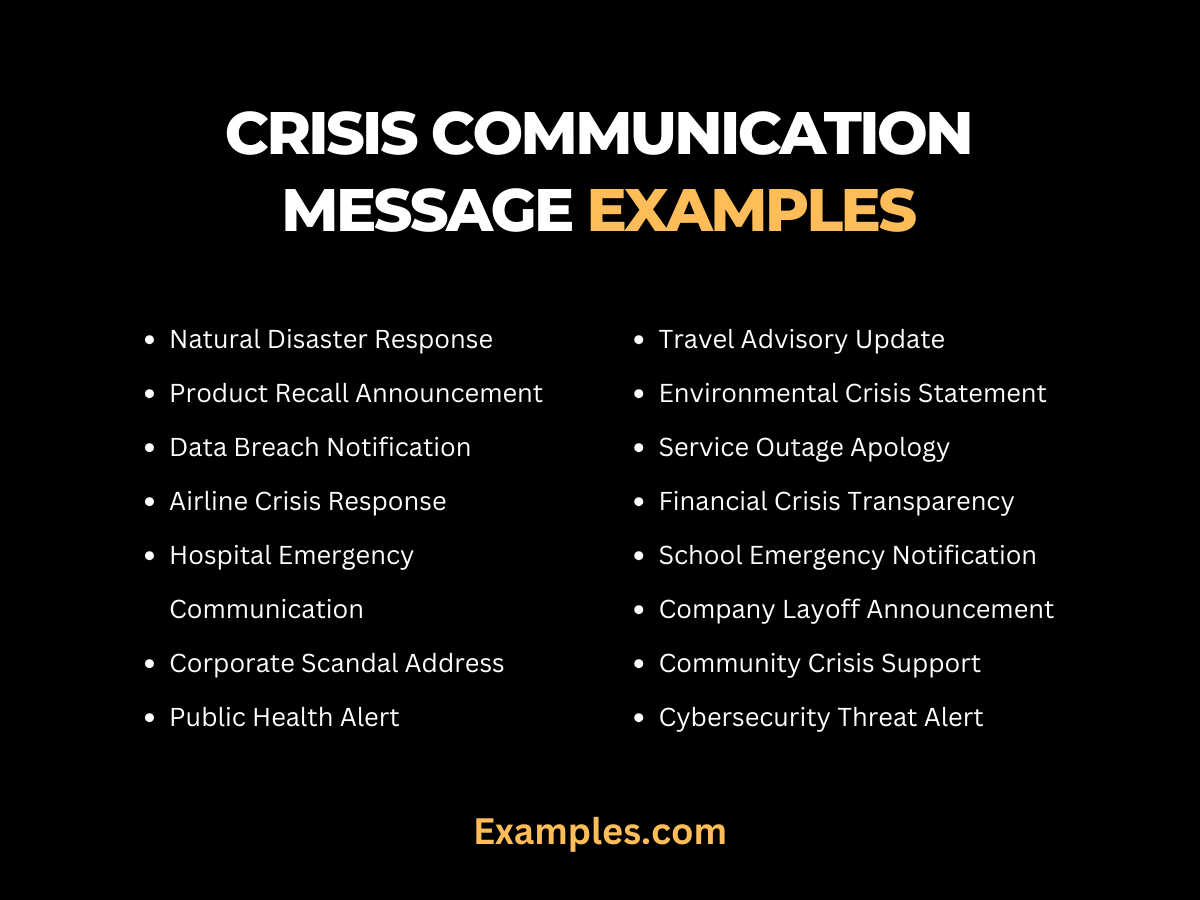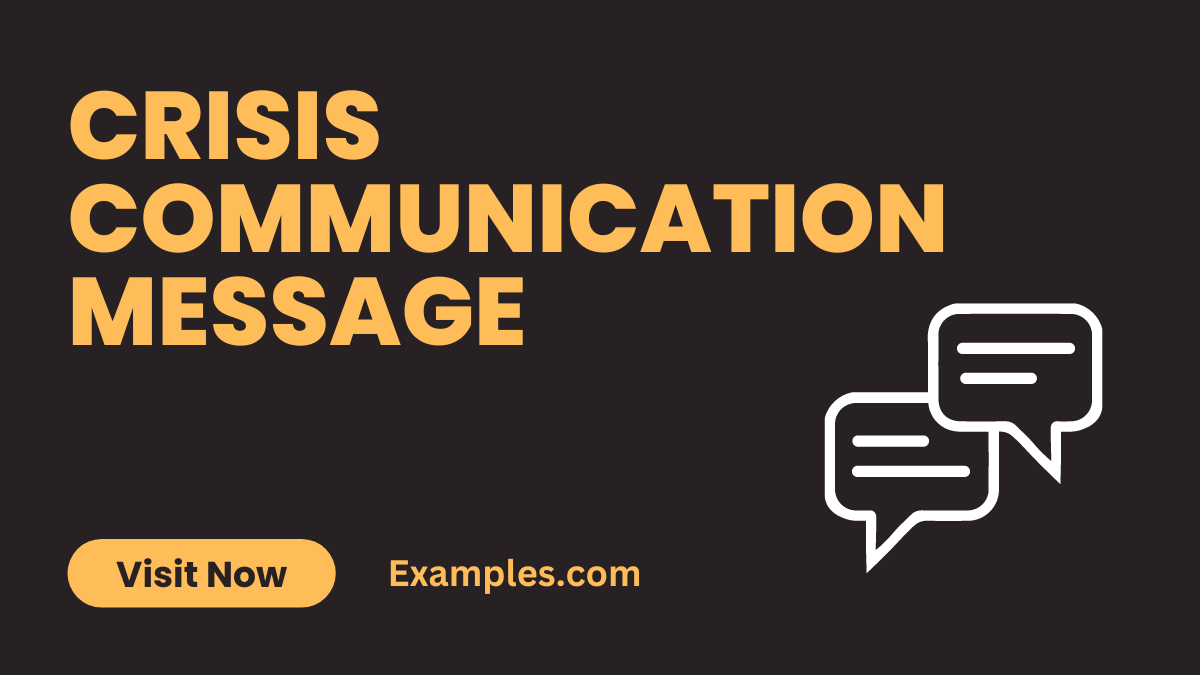Crisis Communication Message
In the unpredictable realm of crisis management, effective communication is paramount. This comprehensive guide offers a deep dive into crisis communication message examples, illustrating how to convey critical information under pressure. Each example serves as a blueprint for crafting messages that are clear, empathetic, and action-oriented, crucial in navigating the crisis at hand. Whether for corporate scenarios, public health emergencies, or natural disasters, these examples are invaluable for anyone looking to hone their crisis communication strategies.
What is a Crisis Communication Message?

A crisis communication message is a strategic statement designed to address and manage a significant unexpected event. These messages aim to inform, reassure, and guide stakeholders during times of uncertainty. Unlike passive communication, which might avoid addressing the issue directly, a crisis communication message is proactive, clear, and often urgent, providing essential information and instructions to mitigate the crisis’s impact.
What is the Best Example of Crisis Communication Message?

An exemplary crisis communication message can be seen in the response of airline companies during emergency situations. For instance, after an incident, an airline’s immediate, transparent, and empathetic communication to the public and families of passengers demonstrates effective crisis management. These messages typically include acknowledgement of the incident, expression of concern for those affected, commitment to safety, and ongoing support – all conveyed with clarity and sensitivity. This approach not only helps in managing the immediate crisis but also in preserving trust and credibility in the long term.
15 Crisis Communication Message Examples

- Natural Disaster Response: “We are actively responding to the recent earthquake, prioritizing the safety of our residents and providing immediate aid.” Explanation: This message acknowledges the disaster and reassures the public about safety measures and aid.
- Product Recall Announcement: “For customer safety, we’re recalling [product] due to [reason]. Please return it for a full refund or replacement.” Explanation: Clear and direct, this message informs customers about a product recall and next steps.
- Data Breach Notification: “We regret to inform you of a data breach. We’re taking all steps to secure systems and protect your information.” Explanation: This message addresses the breach while assuring efforts to protect customer data.
- Airline Crisis Response: “We are deeply saddened by Flight XYZ’s incident. Our focus is on supporting affected families and investigating the cause.” Explanation: This message conveys empathy and commitment to resolving the issue.
- Hospital Emergency Communication: “Due to a power outage, non-urgent appointments are rescheduled. Emergency services continue to operate with backup systems.” Explanation: Informs about operational changes while reassuring continued emergency services.
- Corporate Scandal Address: “We acknowledge the recent allegations. We’re committed to transparency and ethical practices as we investigate these claims.” Explanation: Acknowledges the issue and commits to ethical resolution.
- Public Health Alert: “Alert: a recent outbreak of [disease] has been reported. Follow these safety measures [list]. Stay informed for updates.” Explanation: Provides essential information and safety guidelines to the public.
- Environmental Crisis Statement: “In response to the oil spill, we’re collaborating with authorities and environmentalists for a swift, responsible cleanup.” Explanation: Shows proactive and responsible action in an environmental crisis.
- Travel Advisory Update: “Travel Alert: Due to political unrest in [region], we advise against non-essential travel. Keep updated with our alerts.” Explanation: Offers safety advice and encourages staying informed.
- Service Outage Apology: “We apologize for the unexpected service outage. Our teams are working to restore services as quickly as possible.” Explanation: Apologizes for inconvenience and reassures about resolution efforts.
- Financial Crisis Transparency: “In light of our financial challenges, we’re implementing measures to stabilize and rebuild trust with our stakeholders.” Explanation: Addresses financial issues and outlines recovery steps.
- School Emergency Notification: “Emergency Update: The school is on lockdown due to [situation]. All students are safe. We will provide updates.” Explanation: Informs about an emergency situation while ensuring student safety.
- Company Layoff Announcement: “Regrettably, economic conditions necessitate workforce reductions. We’re committed to supporting affected employees through this transition.” Explanation: Communicates difficult news empathetically, with a focus on support.
- Community Crisis Support: “In response to the community crisis, we’re organizing support and resources. Here’s how you can help [details].” Explanation: Mobilizes community support and provides actionable information.
- Cybersecurity Threat Alert: “We have detected a potential cybersecurity threat. Please ensure your systems are updated and report any suspicious activity.” Explanation: Alerts about a cybersecurity threat and provides preventative steps.
Crisis Communication Messages Examples for Social Media

- Swift and Accurate Updates: On social media, speed is crucial. However, accuracy should not be compromised. It’s vital to provide prompt updates while ensuring the information is verified and factual.
- Empathetic and Clear Tone: Use a tone that is empathetic and understanding. Clear, straightforward language helps in avoiding miscommunication, especially important during a crisis.
- Regular Monitoring and Engagement: Continuously monitor social media channels to address queries and concerns. This shows commitment to effective communication and customer care.
- Consistent Messaging Across Platforms: Ensure that the message is consistent across all digital platforms. This uniformity helps in maintaining a coherent communication strategy.
- Utilize Visual Aids: Sometimes, visualization communication tools like infographics can be more effective in conveying critical information quickly and clearly.
What are Key Messages in Crisis Communication?
- Nature of the Crisis: Clearly state what the crisis is, using direct communication to avoid ambiguity. This helps in setting a clear context for the audience.
- Immediate Actions Taken: Highlight the steps being taken to address the crisis. This reinforces the organization’s proactive approach and commitment to resolving the situation.
- Safety Measures and Instructions: If applicable, provide safety instructions or measures being taken to protect the public. This aligns with responsible communication practices.
- Commitment to Stakeholders: Reaffirm your commitment to stakeholders’ well-being and interests. This helps in maintaining trust and demonstrates corporate communication responsibility.
- Future Updates: Inform your audience about how and when they can expect future updates. This maintains a line of open and transparent communication.
How to Write a Crisis Communication Message?

- Start with a Clear Headline: Begin with a headline that succinctly captures the essence of the message. This aligns with the principles of headline writing in mass communication.
- Provide Essential Information: Clearly state the key facts of the crisis. This includes what happened, the affected parties, and immediate actions taken.
- Show Empathy and Concern: Humanize your message by showing empathy and concern for those affected. This reflects good interpersonal communication skills.
- Offer Guidance and Next Steps: Provide clear instructions or guidance on what stakeholders should do next. This is a crucial aspect of leadership communication in crisis situations.
- Keep It Short and Accessible: Ensure the message is concise and easily understandable. Avoid jargon to make it accessible to a wider audience.
What are the Steps for Crafting a Successful Crisis Communication Message?
- Assess the Situation: Begin by thoroughly assessing the situation to understand its scope and impact. This step is critical for effective communication.
- Identify Your Audience: Tailor your message to your specific audience. Whether it’s customers, employees, or the public, understanding your audience is key.
- Develop Key Messages: Based on your understanding of the crisis, develop key messages that are clear, accurate, and empathetic.
- Choose the Right Channels: Decide on the most appropriate channels for disseminating your message. This might include press releases, social media, or internal communication channels.
- Review and Revise: Before releasing the message, review and revise it to ensure clarity and accuracy. This step is crucial to avoid any potential miscommunication.
In conclusion, this guide on crisis communication message examples offers essential insights into crafting messages that are clear, empathetic, and effective. It underscores the importance of timely response, transparency, and sensitivity during crises. By adhering to these principles, organizations can navigate challenging situations successfully, maintaining trust and credibility while addressing stakeholder concerns and needs with proficiency and care.



